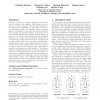Free Online Productivity Tools
i2Speak
i2Symbol
i2OCR
iTex2Img
iWeb2Print
iWeb2Shot
i2Type
iPdf2Split
iPdf2Merge
i2Bopomofo
i2Arabic
i2Style
i2Image
i2PDF
iLatex2Rtf
Sci2ools
PPPJ
2009
ACM
2009
ACM
Phase detection using trace compilation
Dynamic compilers can optimize application code speci’¼ücally for observed code behavior. Such behavior does not have to be stable across the entire program execution to be bene’¼ücial for optimizations, it must only be stable for a certain program phase. To specialize code for a program phase, it is necessary to detect when the execution behavior of the program changes (phase change). Trace-based compilation is an e’¼ācient method to detect such phase changes. A trace tree is a collection of frequently executed code paths through a code region, which is assembled dynamically at run time as the program executes. Program execution tends to remain within such a trace tree during a stable phase, whereas phase changes cause a sudden increase in side exits from the trace tree. Because trace trees are recorded at run time by observing the interpreter, the actual values of variables and expressions are also available. This allows a de’¼ünition of phases based not only on recurring control ’¼...
| Added | 19 May 2010 |
| Updated | 19 May 2010 |
| Type | Conference |
| Year | 2009 |
| Where | PPPJ |
| Authors | Christian Wimmer, Marcelo Silva Cintra, Michael Bebenita, Mason Chang, Andreas Gal, Michael Franz |
Comments (0)

